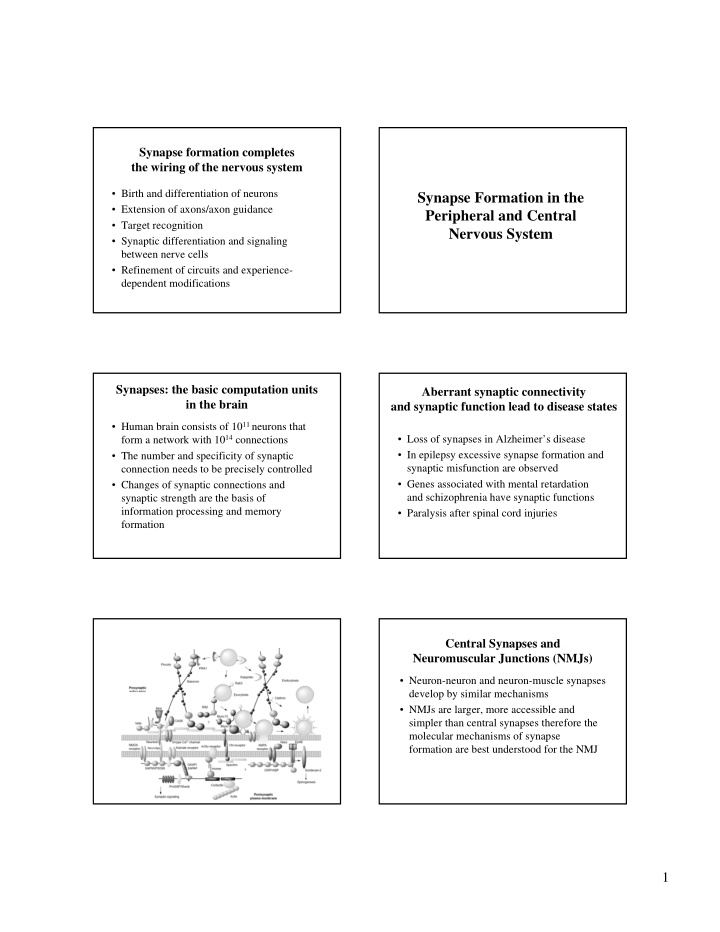



Synapse formation completes the wiring of the nervous system • Birth and differentiation of neurons Synapse Formation in the • Extension of axons/axon guidance Peripheral and Central • Target recognition Nervous System • Synaptic differentiation and signaling between nerve cells • Refinement of circuits and experience- dependent modifications Synapses: the basic computation units Aberrant synaptic connectivity in the brain and synaptic function lead to disease states • Human brain consists of 10 11 neurons that form a network with 10 14 connections • Loss of synapses in Alzheimer’s disease • The number and specificity of synaptic • In epilepsy excessive synapse formation and synaptic misfunction are observed connection needs to be precisely controlled • Genes associated with mental retardation • Changes of synaptic connections and synaptic strength are the basis of and schizophrenia have synaptic functions information processing and memory • Paralysis after spinal cord injuries formation Central Synapses and Neuromuscular Junctions (NMJs) • Neuron-neuron and neuron-muscle synapses develop by similar mechanisms • NMJs are larger, more accessible and simpler than central synapses therefore the molecular mechanisms of synapse formation are best understood for the NMJ 1
Structure of the neuromuscular junction Nerve terminal: • Mature NMJs consist of three cell types - rich in synaptic vesicles – Motor nerve - active zones – Muscle cell - mitochondria - axon are rich in neurofilaments – Schwann cells and contain only few vesicles • All three cell types adopt a highly specialized organization that ensures proper synaptic function Muscle: Schwann Cells: - junctional folds opposing the - thin non-myelin processes that active zones cover nerve terminal - specific cytoskeleton at synapse - myelin sheet around the remaining - strong concentration of ACh-R axon from exit site from the spinal cord to the NMJ vesicles Basal Lamina: - present at synaptic and neurofilament non-synaptic regions, but specific molecular composition at synapse (e.g.: acetylcholinesterase in cleft) ACh-receptors overlay 2
Stages of NMJ Development General Features of Synapse Formation - growth cone approaches 1) The pre- and post-synaptic cell organize each - non-specialized but functional contact others organization (bi-directional signaling) 2) Synapses mature during development - immature specializations – widening of synaptic cleft, basal lamina – transition from multiple innervation to 1:1 - multiple innervation 3) Muscle and nerve contain components required for synaptogenesis (vesicles, transmitter, ACh-R) - elimination of additional axons, � “reorganization” maturation Clustering of ACh-R: Clustering of ACh-R: A) Aggregation of existing receptors B) Local synthesis of receptors The basal lamina directs Agrin clustering of ACh-Rs • Component of the basal lamina Denervation and muscle elimination • 400 kDa proteoglycan (but preservation of muscle satellite cells which will form new myotubes) • Secreted from motor neuron and muscle • Neural form potently induces clustering of ACh-Rs in myotubes In the absence of nerve, ACh-Rs cluster at the original synaptic site Cultured muscle fiber Cultured muscle fiber + agrin 3
Mouse mutants confirm Agrin signals through MuSK essential roles for agrin, MuSK, rapsyn Wild type Agrin mutant • agrin interacts with a MuSK/Masc on the muscle • MuSK is a receptor tyrosine kinase • MuSK activation leads to phosphorylation of rapsyn and clustering of ACh-Rs Rapsyn mutant MuSK mutant A) Aggregation of existing receptors Summary of mutant phenotypes Agrin MuSK • Agrin -/-: few ACh-R clusters, overshooting of axons Rapsyn • MuSK -/-: no ACh-R clusters, overshooting of axons • Rapsyn -/-: no ACh-R clusters, but higher receptor levels in synaptic area, only limited overshooting B) Local synthesis of receptors • Pre-synaptic defects in all mutants , due to the lack of retrograde signals from the muscle ??? Neuregulin (ARIA) • Acetylcholine receptor inducing activity • Expressed in motor neuron and in muscle • Binds and activates receptor tyrosine kinases on the muscle (erbB2, erbB3, erbB4) • Signals through MAP-kinase pathway • Leads to upregulation of ACh-R expression in sub-synaptic nuclei 4
Decrease in ACh-R in Clustering of ACh-R: neuregulin (+/-) heterozygous mice B) Local synthesis of receptors Wild type Heterozygote MEPP (miniature excitatory potential) Three neural signals for the induction Neural activity represses ACh-R of postsynaptic differentiation synthesis in non-synaptic areas • Agrin: aggregation of receptors in the muscle membrane Paralysis • Neuregulin: by upregulation of ACh-R expression in sub-synaptic nuclei Extra-synaptic ACh-R Extra-synaptic ACh-R transcription increased transcription decreased • ACh/neural activity: downregulation of Denervation ACh-R expression in extra-synaptic nuclei Electrical Stimulation Extra-synaptic ACh-R transcription increased Extra-synaptic ACh-R transcription decreased Components of the basal lamina Laminin 11 affects presynaptic can organize the nerve terminal differentiation Laminin β 2 mutant Wild type Denervation + Denervation Muscle elimination Regeneration Regeneration 5
Synaptic inactivity can lead Structure of excitatory synapses in the CNS to synapse elimination Pre-synaptic terminal: Synaptic vesicles pre Pre-synaptic cytomatrix Active zone post Synaptic cleft: 20 nm wide, filled with electron-dense material (proteins and carbohydrates) pre Post-synaptic compartment: Spine structure Dense submembrane scaffold post Neurotransmitter receptors Differences between central synapses Analogies of central synapses and NMJs and NMJs • Overall structural similarities • No basal lamina • Bi-directional signaling • No junctional folds but dendritic spines • Clustering of neurotransmitter receptors • Multiple innervation is common • Synaptic vesicles have similar components • Difference in neurotransmitters: – Excitatory synapses use glutamate • Synapse elimination during development – Inhibitory synapses use GABA ( γ -aminobutyric acid) and glycine • different neurotransmitter receptors Cytoplasmic scaffolding proteins mediate Direct trans-synaptic interactions in the CNS clustering of receptors in the CNS Gephryn PSD95 clusters clusters glycine glutamate receptors receptors • One neuron can receive excitatory and inhibitory inputs through different synaptic connections • Transmitter in presynaptic vesicles is matched with the postsynaptic receptors neuroligin/ neurexin cadherins 6
Neuroligin can induce Direct trans-synaptic interactions in the CNS presynaptic differentiation in CNS neurons neuroligin/ neurexin cadherins Future directions/problems • Many factors that mediate synaptic differentiation in the CNS are not understood • Target specificity • Regeneration after injury is very low in CNS compared to PNS resulting in paralysis • Strategies to improve re-growth of axons and specific synapse formation 7
Recommend
More recommend